Hitler
Targets New York City
|
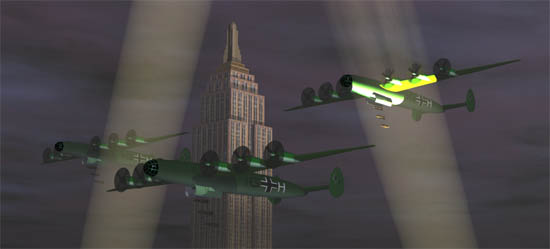
A
squadron of "America Bombers" unleash their deadly
cargo onto New York City. (Copyright Lee
Krystek, 2008)
|
Hitler wanted nothing more than to avenge the
American bombing of German cities with Nazi attacks on the American
homeland cites, like New York. He failed, but how close did he
come?
In March, 1938, Germany annexed Austria. Seven
months later Hitler's armies marched into the Sudetenland, and
by March of 1939 they occupied all of Czechoslovakia. In September,
the Germans invaded Poland. By April of 1940, Denmark and Norway
had fallen. One month later Hitler's troops entered France and
by June a surrender was signed in Paris. Then, with most of the
European continent under his control, Hitler began preparation
for the invasion of the British Isles.
Even as his bombers pounded English cities during
the Battle of Britain, Hitler was planning his next attacks against
other nations. His unsuccessful campaign against the Soviet Union
is well documented. What has remained unknown for decades, however,
was that Hitler also had intentions to target the United States'
homeland for war, so he ordered his military planners and researchers
to create the weapons needed for a deadly attack on America.
The"
America Bomber"
While searching military archives at Potsdam, German
researcher Olaf Groehler came across something that historians
had thought either never existed, or had been lost in the confusion
at the end of the war: a plan for the transatlantic bombing of
the United States. The plan was completed in April of 1942 and
included maps with projected flight paths and targets. The list
of targets included a number of businesses which manufactured
vital military equipment including the Pratt & Whitney plant at
East Hartford, Connecticut, which made aircraft engines; the Sperry
Gyroscopes factory in Brooklyn, New York, which built instrumentation
for aircraft; and the Curtiss Wright Corp. works at Caldwell,
NJ, which machined airplane propellers. In all, 21 factories up
and down the east coast were listed as potential targets of military
value.
|
The
Siverbird Space Bomber
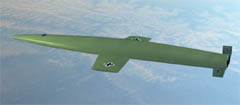
Attacking New
York City with a rocket-powered bomber was proposed by Dr.
Eugen Sanger in 1942. His idea was a reusable, manned craft
that would drop a single, TV-guided bomb on the city from
near space. His plane, the "Silverbird", launched from Europe,
would have been shot down a 2-mile long track driven by
a rocket sled. The sled would stay on the ground but the
bomber would use the momentum it gained to climb to 5,550
feet where its own engine would ignite and push the plane
to a height of 90 miles. From there it would be able to
extend its flight by bouncing off the denser atmospheric
layer at 25 miles above the ground like a stone skipping
across a pond. Over NYC it would drop its single 8,800 pound
bomb, then reenter the atmosphere and land in Japanese controlled
territory in the Pacific.
Though the idea
was ingenious, Sanger underestimated the heat that would
have been generated by friction with the atmosphere. The
craft, if built as designed, would have burned up. More
heat shielding would have solved the problem, but would
have drastically decreased the bomber's payload.
|
To reach these targets, however, the Germans needed
more than plans. They needed planes. Specifically, long-range
bombers capable of reaching the North American continent from
Europe. As early as 1938, Hermann Goring, the head of Luftwaffe,
recognized this gap in his air force's armaments. In a speech
to aircraft manufacturers he said, "I completely lack the bombers
capable of round-trip flights to New York with a 5-ton bomb load.
I would be extremely happy to possess such a bomber which would
at last stuff the mouth of arrogance across the sea."
The desire of the Nazi high command to strike at
the United States only increased as the war went on. American
bombers based in Britain were pounding German factories and cities
into rubble. While the Germans could attempt to hit the British
airfields where those bombers were based, they could not take
direct revenge on U.S. targets in North America.
Back in 1937, German aircraft manufacturer Willy
Messerschmitt began thinking about building a long-range bomber.
The airplane was designated the Me 264 and designed with four
engines to give the craft a range of 12,428 miles carrying a bomb
load of 11,000 pounds. According to historians, Hitler himself
was very enthused about the project when shown a mock-up of the
plane early in its development.
Despite this, the Me 264 and other long range bombers
only got intermittent support from the Nazi government in the
late 30's. In the philosophy of German military planners, the
air force was meant to support the work of an advancing army.
With the airfields never far behind the front lines, only medium
range bombers were needed for this type of mission. Most German
generals saw no need for strategic bombers that could strike deep
into the enemy's heartland,. especially when they saw they could
build two and a half medium range bombers for the price of one
long-range bomber. Their philosophy worked well as long as Hitler's
armies continued advancing quickly through Europe in a Blitzkrieg
(or "lightning war"). However, when the conflict dragged on and
turned to a war of attrition with each side trying to win by reducing
the others ability to resupply their armies, this philosophy began
to fail.
It wasn't until August of 1940 that the priority
of the Me 264 project changed when it was determined that German
objectives in Africa required a bomber with a range of at least
3,728 miles. Soon after that the air ministry got serious about
attacking the United States from France and issued requirements
for a bomber that could make a round-trip of 7,457 miles. In 1941,
Messerschmitt got the contract to build six prototypes of the
Me-264 and was told that if he met requirements, the German government
would order an additional 24 planes for use against the United
States. At the same time Messerschmitt started planning a six-engine
version of the craft to further increase the payload and range
of the plane.
|
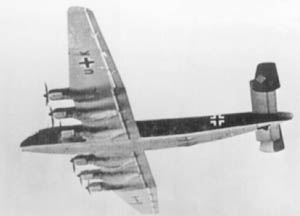
A
Junkers 390: the largest bomber of the war.
|
Messerschmitt wasn't the only manufacturer working
on an "America Bomber." The Junkers Company, which was controlled
by the Luftwaffe, had a successful medium-range bomber in the
Ju 290 and scaled it up to produce the Ju-390. The plane was powered
by six 1,700-horsepower engines. With a length of 110 feet and
a wingspan of 181 feet, it was the largest bomber built by either
side during the war. Heinkel, another aircraft company, scaled
up their medium bomber, the He 177 to create the He 277 four-engine
aircraft. Focke-Wulf designed a six-engine bomber (the Ta 400)
and Horten planned a "flying wing" bomber powered by six turbo
jet engines, the Ho 18.
Three prototype Me 264s, two Ju 390s and as many
as eight He 277s were actually built. Neither the Ta 400 or the
Ho 18 made it past wind tunnel tests with scale models. Fortunately
for the United States, as the war progressed the Germans were
under pressure to build as many defensive aircraft as possible
and this kept the America Bomber programs from having the priority
to move forward at anything but a snail's pace. The war ended
before any actual missions were ever conducted, though it is rumored
a Ju 390 flew a test flight that came within 12 miles of New York
City and photographed the Long Island coastline.
Missile
Attack
Hitler's plans also included the use of new "miracle"
weapons to win the war. In June of 1944, Germany deployed the
world's first cruise missile to be used in combat: the V-1. The
V-1 was a small, pilotless plane launched from a long ramp and
powered by a pulse-jet. The craft could carry its nearly 2,000
pound warhead a distance of 150 miles to a remote target. The
Germans initially launched the V-1 from locations in France with
most landing in the vicinity of the city of London. The British
found the V-1 difficult to stop. It flew too fast for most anti-aircraft
guns to target and too fast for most fighter planes to overtake.
Even if the craft was hit by gunfire, it wouldn't necessarily
go down. Without a pilot or complex engine there were few points
on the missile vulnerable to a single shot. During the course
of the war almost 23,000 people were killed by the V-1 and while
defensive measures got better with time - faster fighters, better
anti-aircraft guns - the threat to London was not completely removed
until the Allied troops overran theV-1's launch points.
|
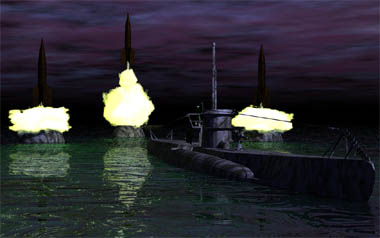
Three
V-2s launch from their uboat-towed canisters in Project
Prufstand XII. (Copyright Lee Krystek,
2008)
|
The introduction of the V-1 was followed by the
V-2 (sometimes referred to by its development name, the A-4).
The V-2 was the first ballistic missile ever used in war. The
rocket stood 46 feet high and could carry a 2150 pound warhead
200 miles. Unlike the V-1, there were no defensive measures that
could ever be devised against its threat. With an incoming velocity
of nearly four times the speed of sound, nothing could catch it
or stop it. It caused 2,745 deaths in London before its launch
sites were overrun.
In the autumn of 1943 the Germans began to develop
a plan that would have allowed them to attack American cities
using the V-2 weapon. The idea came from Dr. Bodo Lafferentz,
one of the Third Reich's most brilliant engineers. Lafferentz
proposed building sealed canisters big enough to contain a V-2
and towing them behind a submarine to within 100 miles of the
United States coast. It was estimated one submarine could tow
up to three of these hundred-foot-long, torpedo-shaped canisters.
Upon arrival the submarine would surface and remote controls would
be used to flood the back end of the canisters to bring them from
a horizontal position to a vertical one with just their tops clearing
the surface of the ocean. The exposed end of the canisters would
then be opened and technicians would enter the floating silos
to prepare the V-2s for flight. The Germans estimated that within
thirty minutes the V-2s could be readied and launched. With the
rockets on their way, the U-boat could then cut its connection
to the canisters and flood them with water to sink them to the
bottom. The submarine could then return to Germany while the three
missiles continued on to plow into New York or some other American
metropolis.
The project, given the name "Prufstand XII," was
approved and construction of three prototype canisters was started
early in 1945. The canisters were still under construction when
the Soviets captured the shipyard where they were being built
in April of 1945.
|
Hitler's
Lost Opportunity
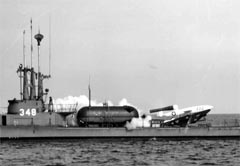
Hitler's desire
to strike at the United States by submarine might have easily
been fulfilled by ignoring the more glitzy (but complicated)
V-2 and using the V-1. The Americans tested this idea with
their version of the V-1 , the Loon, in 1947. A short
ramp and hanger was added to the back of the submarine USS
Cusk (above) and it was able to successfully launch
the V-1 clone, track it by radar and guide it by radio to
a target. Surprisingly, the Germans never attempted to do
this, though the head of Hitler's navy, Admiral Karl Admiral
Donitz, did attend a test firing of a V-1 in 1943. His presence
there may have been related to this approach. It is clear
that if the Germans had spent even a little time developing
this idea there is no doubt they could have used such an
arrangement to send a few V-1s into the heart of New York,
or any other American east coast city.
|
Would the scheme have worked? Perhaps. The plan's
biggest weakness, beyond the difficulty of towing some huge objects
underwater for thousands of miles, was the inability of the Germans
to guide the V-2 to a specific target. With a little luck the
rocket could hit something as big as the city of London from a
fixed base 200 miles away. Given the difficulty of precisely positioning
the canisters at sea, it seems very unlikely that a target of
any real military value could be struck, though the device might
still serve as a terror weapon against highly-populated areas.
The
New York Rocket
The Germans were also working on other ways to launch
missiles at the Americans beyond the idea of towing them within
range behind submarines. As early as 1941, engineers were thinking
of how to extend the range of the V-2 /A-4. The easiest change
was to add two wings to the rocket (renaming it the A-4B). This
would allow the device t not to just simply plunge straight down
when its fuel was exhausted, but operate as a high-speed glider.
While this improved the distance it could travel
to nearly 400 miles, it was still very short of the range needed
to cross the Atlantic. To solve this problem the German engineers
came up with the idea of adding a booster stage to the A-4. This
large rocket, designated the A-10, would carry an A-4 on top of
it. The A-10 could boost the A-4 to an altitude of 35 miles, then
would drop away, allowing the A-4's engine to take over and carry
it the rest of the way. A new version of the A-4 (called the A-9)
was planned to operate with the A-10. Like the A-4B it had wings,
but these were envisioned to be extensions of the two rear stabilizer
fins that ran the length of the craft. One German scientist, Walter
Dornberger, estimated that the A-9/10 combination would "cover
2,500 miles in about 35 minutes," making it the first intercontinental
ballistic missile.
Guiding such a missile to a target, even a city-sized
target, though, would be even more difficult than it was with
the V-2. One way to solve this problem was to make the A-9 manned.
The pilot would point his high-speed glider toward its final target,
usually thought of as the Empire State Building, then bail out
to be recovered and brought back to Germany by a lurking submarine.
An alternative proposal would have involved using U-boats to plant
a series of floating radio beacons in a path across the Atlantic
with the final one placed in a New York hotel by German spies.
The rocket could then simply follow the radio signals to the target.
Fortunately the war ended before any of these ideas
could be tried. Would they have worked? The Germans thought so.
In 1944 aerial photographs showed seven large concrete structures
of unknown purpose being built in France. It was later determined
that these bunkers were to be used for the launching of rockets
- thought to be either the V-1 or V-2. Most of these bunkers were
oriented facing London or Bristol. The Americans became alarmed,
however, when one of the seven, located at Wizernes, was found
to be facing New York City. Though the bunkers were never used
for their intended purposes, when the one at Wizernes was captured,
it was found to have bombproof doors twice the size needed for
the V2/A4. Though no records exist as to why this was so, historians
speculate that this was supposed to be the launch site of the
A10/A9 New York rocket.
Given time, such a project might well have succeeded.
A postwar study by the US Navy evaluated the A9/A10 launch system
and concluded it was "scientifically possible and undoubtedly
would have been realized had time permitted." Skeptics of this
viewpoint only need to remember that many of the Nazi scientists
working on the A10/A9 were recruited by the United States and
the Soviet Union after the war. Under their new nationalities
they successfully built the first nuclear tipped Intercontinental
Ballistic Missiles which made the threat of global thermo-nuclear
war possible.
Impact
if Successful
What would have been the result if one or several
of these plans had actually worked? It seems impossible that it
would have changed the final outcome of the war. The attacks,
if directed against factories, would have been too few and too
sporadic to actually have significantly lowered the production
of war materials. Attacks on cities would have killed a small
number of civilians and frightened the population, but some historians
argue that this would simply have outraged the Americans and caused
them to deal even more harshly with German cities during bombing
raids toward the end of the war.
There is a chance, however, that such attacks could
have led to the war being lengthened. A successful attack on the
United States would have greatly boosted the moral in Germany
in the same way that the successful American air raid against
Japan in 1942, led by Lieutenant Colonel James "Jimmy" Doolittle,
raised American spirits. Doolittle's 16 B-25 bombers did negligible
damage to the Japanese war machine but caused the Japanese to
recall some of their fighter units back to the home islands for
defense and change important war strategies.
In the same way attacks on the U.S. east coast might
have caused a public outcry forcing the U.S. military to devote
more of their resources toward homeland defense. This, of course,
would have tied up men and ships that were actually used to push
the war in Europe quickly to a close. Such a change in plans might
well have had the effect of lengthening the Third Reich's rule
of terror.
|
An
A-10 booster drops away as an A-9 ignites its engine to
carry it on its way to a strike on New York City. (Copyright
Lee Krystek, 2008)
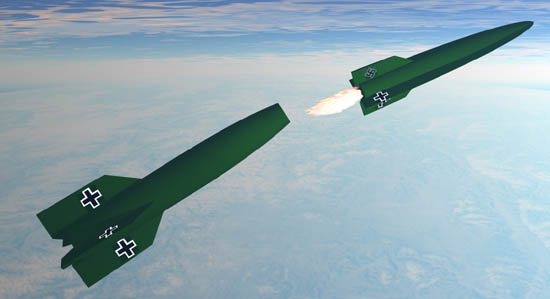
|
A Partial Bibliography
Target America: Hitler's Plan to Attack the United States
by James P. Duffy, The Lyons Press, 2004.
Luftwaffe over America: The Secret Plans to Bomb the United
States in World War II by Manfred Griehl, Greenhill Books,
2006.
Germany's Secret Weapons in World War II by Roger Ford,
Zenith Press, 2000.

Copyright Lee Krystek
2008. All Rights Reserved.